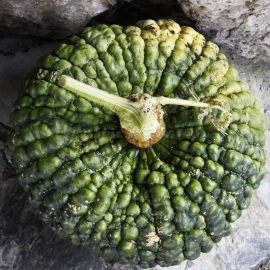









«Marina di Chioggia» - Organic Pumpkin Seeds
1.14 €
The large turban-shaped fruits are deep blue-green. It is one of the most beautiful and unique of all squash. A perfect variety for market gardeners. The rich, sweet flesh is a deep yellow-orange and of good quality, delicious baked or in pies.
-
Heirloom Pumpkin «Marina di Chioggia»
The heirloom sea pumpkin of Chioggia, a fishing village on the coast of Italy, south of Venice. The large turban-shaped fruits are deep blue-green. It is one of the most beautiful and unique of all squash. A perfect variety for market gardeners.
The rich, sweet flesh is a deep yellow-orange and of good quality, delicious baked or in pies. The fruits weigh about 10 lbs each and are produced on vigorous vines. Originally from South America this warty winter squash made its way back to Spain and found its popularity in Italy. This dark orange and sweet fleshed fruit was introduced to Venice in the late 1600s and quickly became a beloved addition to the culinary culture. The network of lagoons south of Venice has been inhabited since the 5th century.
Originally the people there fished and hunted small game, harvested sea salt, grew fruit, and eventually vegetables. The region became a major source of vegetables for the Venetians once the salt marshes were drained and cultivated. Winter squash became a key staple for the winter months and especially for the poor who could not afford or access meat as readily.
The rich, dense texture of Marina di Chioggia, storing for up to six months, filled this winter food gap and its incredible depth of flavor quickly spread throughout Italy and the world. This beauty of a squash is still served on the canals of Venice. Grilled with olive oil by the bargemen and served as a whole wedge. A sweet and savory delight, for sure! Its meaty and sweet texture has also made this pumpkin popular as a filling for ravioli and for making gnocchi.
How to grow
Timing
Direct sow or transplant in late May or early June when soil warms up. For transplants, start seeds indoors during the first two weeks of May. Make sure plants go into the ground no later than June 15th. Optimal soil temperature for germination: 25-35°C (68-95°F). Seeds should sprout in 7-14 days.
Starting
Sow seeds 2cm (1″) deep. Sow 3 seeds in each spot you want a plant to grow and thin to the strongest plant. Space plants at a minimum of 90-120cm (36-48″) apart in rows 120-180cm (48-72″) apart. If starting transplants indoors, consider using the 12-cell plug inserts.
Growing
Ideal pH: 6.0-6.8. These big plants need lots of food! Choose a sunny spot with fertile, well-draining soil. Dig in a generous quantity of finished compost and/or composted manure. Dig in 1 cup of complete organic fertilizer under each plant. All pumpkins grow male flowers first, then the female flowers are produced. The female flowers have tiny fruits at the base of the petals and require pollination by bees, mostly. Incomplete pollination is common at the beginning of the season, and results in small fruits that are misshapen at the flower end. Discard these damaged fruits before they rot.
For the largest pumpkins, feed weekly throughout the growing season with fish or kelp based fertilizer. Keep the huge plants well watered, particularly in hot weather. Always water the soil, and avoid any form of overhead watering other than rain. Fruit will grow larger if you keep only one fruit per vine. As the fruit develops, try to gently encourage it to grow at a 90° angle to the vine itself. The largest pumpkin varieties will grow on their sides.
Harvest
Like other winter squash, pumpkins are mature when they have coloured up well and their stems are crisp. For the best sugar content, cut the stem about 4cm (2″) or so from the body of the fruit. If the weather is dry, allow the pumpkins to cure in the field for 10 days, or in a warm room for 4-5 days. Bring pumpkins in under cover before rain.
